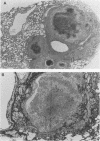Abstract
Male Sprague-Dawley rats were treated with cortisone acetate and fed a low-protein diet for 3 weeks. At the end of week 2, animals were infected intratracheally with 10(5) conidia of Aspergillus fumigatus H11-20. Despite discontinuation of steroids and the low-protein diet 1 week after the infection, 94% of controls died of invasive pulmonary aspergillosis within 3 weeks postinfection. When rats were treated with a single dose of 1.6 mg of aerosolized amphotericin B per kg of body weight 48 h prior to the infection, mortality was reduced to 11% within 3 weeks postinfection. Despite apparent good health and rapid weight gain, all survivors showed multiple lesions in histopathological sections of the lungs, and 10(3) to 10(4) CFU of aspergilli was recovered from cultures of their lungs. With discontinuation of immunosuppression, the infection was slowly cleared; however, when cortisone acetate was restarted during week 5, reactivation of progressive invasive pulmonary aspergillosis was observed. On the basis of these results, we conclude that a single low dose of aerosolized amphotericin B prophylaxis is effective in preventing an exogenous aspergillus infection of the lung. Additional therapy is needed to prevent recurrent infection caused by endogenous aspergilli when immunosuppression is resumed.
Full text
PDF





Images in this article
Selected References
These references are in PubMed. This may not be the complete list of references from this article.
- Aisner J., Schimpff S. C., Bennett J. E., Young V. M., Wiernik P. H. Aspergillus infections in cancer patients. Association with fireproofing materials in a new hospital. JAMA. 1976 Jan 26;235(4):411–412. [PubMed] [Google Scholar]
- Armstrong D. Problems in management of opportunistic fungal diseases. Rev Infect Dis. 1989 Nov-Dec;11 (Suppl 7):S1591–S1599. doi: 10.1093/clinids/11.supplement_7.s1591. [DOI] [PubMed] [Google Scholar]
- Cordonnier C., Bernaudin J. F., Bierling P., Huet Y., Vernant J. P. Pulmonary complications occurring after allogeneic bone marrow transplantation. A study of 130 consecutive transplanted patients. Cancer. 1986 Sep 1;58(5):1047–1054. doi: 10.1002/1097-0142(19860901)58:5<1047::aid-cncr2820580512>3.0.co;2-y. [DOI] [PubMed] [Google Scholar]
- Dixon D. M., Polak A., Walsh T. J. Fungus dose-dependent primary pulmonary aspergillosis in immunosuppressed mice. Infect Immun. 1989 May;57(5):1452–1456. doi: 10.1128/iai.57.5.1452-1456.1989. [DOI] [PMC free article] [PubMed] [Google Scholar]
- Dupont B., Huber M., Kim S. J., Bennett J. E. Galactomannan antigenemia and antigenuria in aspergillosis: studies in patients and experimentally infected rabbits. J Infect Dis. 1987 Jan;155(1):1–11. doi: 10.1093/infdis/155.1.1. [DOI] [PubMed] [Google Scholar]
- Epstein S. M., Verney E., Miale T. D., Sidransky H. Studies on the pathogenesis of experimental pulmonary aspergillosis. Am J Pathol. 1967 Nov;51(5):769–788. [PMC free article] [PubMed] [Google Scholar]
- Graybill J. R., Kaster S. R. Experimental murine aspergillosis. Comparison of amphotericin B and a new polyene antifungal drug, SCH 28191. Am Rev Respir Dis. 1984 Feb;129(2):292–295. [PubMed] [Google Scholar]
- Lehmann P. F., White L. O. Acquired immunity to Aspergillus fumigatus. Infect Immun. 1976 Apr;13(4):1296–1298. doi: 10.1128/iai.13.4.1296-1298.1976. [DOI] [PMC free article] [PubMed] [Google Scholar]
- Meunier F. New methods for delivery of antifungal agents. Rev Infect Dis. 1989 Nov-Dec;11 (Suppl 7):S1605–S1612. doi: 10.1093/clinids/11.supplement_7.s1605. [DOI] [PubMed] [Google Scholar]
- Meyer R. D., Young L. S., Armstrong D., Yu B. Aspergillosis complicating neoplastic disease. Am J Med. 1973 Jan;54(1):6–15. doi: 10.1016/0002-9343(73)90077-6. [DOI] [PubMed] [Google Scholar]
- Niki Y., Bernard E. M., Schmitt H. J., Tong W. P., Edwards F. F., Armstrong D. Pharmacokinetics of aerosol amphotericin B in rats. Antimicrob Agents Chemother. 1990 Jan;34(1):29–32. doi: 10.1128/aac.34.1.29. [DOI] [PMC free article] [PubMed] [Google Scholar]
- Patterson T. F., Miniter P., Dijkstra J., Szoka F. C., Jr, Ryan J. L., Andriole V. T. Treatment of experimental invasive aspergillosis with novel amphotericin B/cholesterol-sulfate complexes. J Infect Dis. 1989 Apr;159(4):717–724. doi: 10.1093/infdis/159.4.717. [DOI] [PubMed] [Google Scholar]
- Patterson T. F., Miniter P., Ryan J. L., Andriole V. T. Effect of immunosuppression and amphotericin B on Aspergillus antigenemia in an experimental model. J Infect Dis. 1988 Aug;158(2):415–422. doi: 10.1093/infdis/158.2.415. [DOI] [PubMed] [Google Scholar]
- Rhame F. S., Streifel A. J., Kersey J. H., Jr, McGlave P. B. Extrinsic risk factors for pneumonia in the patient at high risk of infection. Am J Med. 1984 May 15;76(5A):42–52. doi: 10.1016/0002-9343(84)90243-2. [DOI] [PubMed] [Google Scholar]
- Robertson M. J., Larson R. A. Recurrent fungal pneumonias in patients with acute nonlymphocytic leukemia undergoing multiple courses of intensive chemotherapy. Am J Med. 1988 Feb;84(2):233–239. doi: 10.1016/0002-9343(88)90419-6. [DOI] [PubMed] [Google Scholar]
- SIDRANSKY H., FRIEDMAN L. The effect of cortisone and antibiotic agents on experimental pulmonary aspergillosis. Am J Pathol. 1959 Jan-Feb;35(1):169–183. [PMC free article] [PubMed] [Google Scholar]
- Schmitt H. J., Bernard E. M., Häuser M., Armstrong D. Aerosol amphotericin B is effective for prophylaxis and therapy in a rat model of pulmonary aspergillosis. Antimicrob Agents Chemother. 1988 Nov;32(11):1676–1679. doi: 10.1128/aac.32.11.1676. [DOI] [PMC free article] [PubMed] [Google Scholar]
- Schwartz R. S., Mackintosh F. R., Schrier S. L., Greenberg P. L. Multivariate analysis of factors associated with invasive fungal disease during remission induction therapy for acute myelogenous leukemia. Cancer. 1984 Feb 1;53(3):411–419. doi: 10.1002/1097-0142(19840201)53:3<411::aid-cncr2820530308>3.0.co;2-e. [DOI] [PubMed] [Google Scholar]
- Talbot G. H., Weiner M. H., Gerson S. L., Provencher M., Hurwitz S. Serodiagnosis of invasive aspergillosis in patients with hematologic malignancy: validation of the Aspergillus fumigatus antigen radioimmunoassay. J Infect Dis. 1987 Jan;155(1):12–27. doi: 10.1093/infdis/155.1.12. [DOI] [PubMed] [Google Scholar]
- White L. O. Germination of Aspergillus fumigatus conidia in the lungs of normal and cortisone-treated mice. Sabouraudia. 1977 Mar;15(1):37–41. [PubMed] [Google Scholar]
- Wilson E. V., Hearn V. M., Mackenzie D. W. Evaluation of a test to detect circulating Aspergillus fumigatus antigen in a survey of immunocompromised patients with proven or suspected invasive disease. J Med Vet Mycol. 1987 Dec;25(6):365–375. [PubMed] [Google Scholar]




